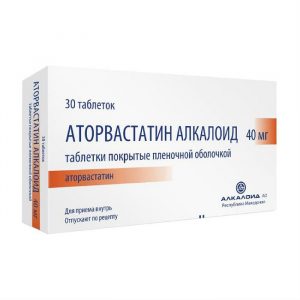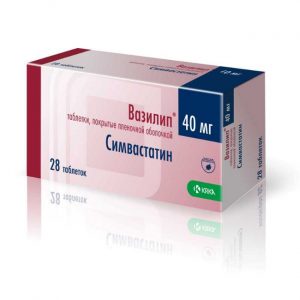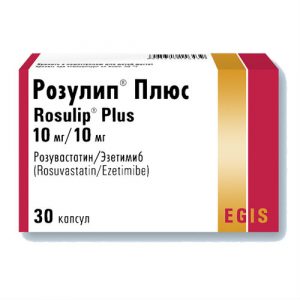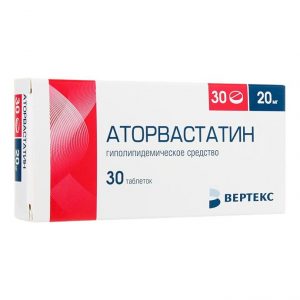Description
Packing
90 pcs.
Pharmacological action
Rosart – a lipid-lowering drug from the group of statins. Selective competitive inhibitor of 3-hydroxy-3-methylglutaryl coenzyme A (HMG-CoA) – reductase – an enzyme that converts HMG-CoA to mevalonate, a precursor of cholesterol. It increases the number of low density lipoprotein receptors (LDL) on the surface of hepatocytes, which leads to increased uptake and catabolism of LDL, inhibition of very low density lipoprotein synthesis (VLDL), reducing the total number of LDL and VLDL.
Reduces elevated concentrations of LDL cholesterol, low-density lipoprotein cholesterol (non-HDL), VLDL cholesterol, total cholesterol, triglycerides (TG), VL-VLDL, apolipoprotein B (ApoV), lowers the ratio of total cholesterol-LP-Lp-cholesterol-Lp / Lp cholesterol / HDL cholesterol, non-HDL cholesterol / HDL cholesterol, ApoV / apolipoprotein AI (ApoA-I), increases the concentration of HDL cholesterol and ApoA-I.
Hypolipidemic effect is directly proportional to the size of the prescribed dose. The therapeutic effect appears within 1 week after the start of therapy, after 2 weeks reaches 90% of the maximum, by 4 weeks reaches a maximum and after that remains constant. Effective in adult patients with hypercholesterolemia with or without hypertriglyceridemia (regardless of race, gender or age), including in patients with diabetes mellitus and familial hypercholesterolemia. In 80% of patients with type IIa and IIb hypercholesterolemia (Fredrickson classification) with an average baseline LDL cholesterol of about 4.8 mmol / L while taking the drug at a dose of 10 mg, the LDL cholesterol concentration reaches values of less than 3 mmol / L. In patients with homozygous familial hypercholesterolemia taking the drug at a dose of 20 mg and 40 mg, the average decrease in LDL cholesterol concentration is 22%.
The additive effect is observed in combination with fenofibrate (in relation to a decrease in the concentration of TG) and with nicotinic acid in lipid lowering doses> 1 g / day (in relation to an increase in the concentration of HDL cholesterol).
Pharmacokinetics
Absorption
The maximum concentration (Cmax) of rosuvastatin in plasma is reached approximately 5 hours after taking the drug. Absolute bioavailability is approximately 20%. The systemic exposure of rosuvastatin increases in proportion to the dose. Pharmacokinetic parameters do not change with daily use.
Distribution
Crosses the placental barrier. Rosuvastatin is predominantly absorbed by the liver, which is the main site of cholesterol synthesis and metabolism of LDL-C. Distribution volume – 134 l. Binding to plasma proteins (mainly with albumin) is approximately 90%.
Metabolism
Biotransformed in the liver to a small extent (about 10%), being a non-core substrate for isoenzymes of the cytochrome P450 system. As in the case of other HMG-CoA reductase inhibitors, a specific membrane carrier is involved in the process of hepatic uptake of the drug – a polypeptide transporting the organic anion (OATP) 1B1, which plays an important role in its hepatic elimination. The main isoenzyme involved in the metabolism of rosuvastatin is CYP2C9. Isoenzymes CYP2C19, CYP3A4, and CYP2D6 are less involved in metabolism. The main metabolites of rosuvastatin are N-desmethyl and lactone metabolites. N-desmethyl is approximately 50% less active than rosuvastatin, lactone metabolites are pharmacologically inactive. More than 90% of the pharmacological activity in inhibiting circulating HMG-CoA reductase is provided by rosuvastatin, the rest is metabolites.
Excretion
About 90% of the dose of rosuvastatin is excreted unchanged through the intestines, the remainder by the kidneys. The half-life (T1 / 2) is approximately 19 hours, does not change with an increase in the dose of the drug. The average plasma clearance is approximately 50 l / h (coefficient of variation 21.7%).
In patients with mild to moderate renal failure, the plasma concentration of rosuvastatin or N-desmethyl does not change significantly. In patients with severe renal failure (creatinine clearance (CC) less than 30 ml / min), the concentration of rosuvastatin in plasma is 3 times higher, and N-desmethyl is 9 times higher than in healthy volunteers. The plasma concentration of rosuvastatin in patients on hemodialysis is approximately 50% higher than in healthy volunteers.
Patients with various stages of liver failure with a score of 7 or lower on the Child-Pugh scale did not show an increase in T1 / 2 of rosuvastatin in patients with a score of 8 and 9 on the Child-Pugh scale, a 2-fold elongation of T1 / 2 was noted. There is no experience with the use of the drug in patients with more severe impaired liver function. Gender and age do not have a clinically significant effect on the pharmacokinetics of rosuvastatin. Pharmacokinetic parameters depend on race: the area under the concentration-time curve (AUC) in Japanese and Chinese is 2 times higher than that of residents of Europe and North America. In representatives of the Mongoloid race and Indians, the average value of AUC and Cmax increases by 1.3 times.
Indications
Primary hypercholesterolemia (type IIa according to Fredrickson), including heterozygous hereditary hypercholesterolemia) or mixed (combined) hyperlipidemia (type IIb according to Fredrickson), as an adjunct to diet and other non-pharmacological measures a form of hereditary hypercholesterolemia with insufficient effectiveness of diet therapy and other types of treatment aimed at lowering lipids (for example, LDL apheresis) or, if such eniya not fit the patient.
Hypertriglyceridemia (type IV Fredrickson supplementation) as a diet supplement.
To slow the progression of atherosclerosis as a supplement to the diet in patients who are shown therapy to lower total cholesterol and LDL cholesterol.
Prevention of major cardiovascular complications (stroke, heart attack, arterial revascularization) in adult patients without clinical signs of coronary heart disease (CHD), but with an increased risk of its development (over 50 years old for men and over 60 years old for women, increased concentration C-reactive protein ( 2 mg / l) in the presence of at least one of the additional risk factors, such as arterial hypertension, low concentration of HDL cholesterol, smoking, a family history of early onset of CHD).
Contraindications
liver disease in the active phase, including a persistent increase in serum activity of hepatic transaminases (more than 3 times compared with VGN) of unknown genesis
severe renal impairment (CC less than 30 ml / min)
myopathy
simultaneous administration women of reproductive age pregnancy and lactation
not using adequate contraceptive methods
age up to 18 years (efficacy and safety not established)
lactose intolerance, lactase deficiency, glucose-galactose malabsorption (the drug contains lactose monohydrate)
hypersensitivity to rosuvastatin or other components of the drug rosuvastatin or while taking other HMG-CoA reductase inhibitors or fibrates with a history of
hypothyroidism
moderate renal failure (CC less than 60 ml / min)
excessive alcohol consumption
conditions that can lead to increased plasma concentrations of rosuvastatin
concomitant use of fibrates.
Patients of the Mongoloid race.
Family history of muscle disease.
Caution: the presence of risk factors for the development of myopathy and / or rhabdomyolysis – renal failure (CC more than 30 ml / min), hypothyroidism, personal or family history of hereditary muscle diseases and a previous history of myotoxicity with other HMG-CoA reductase inhibitors or fibrates excessive alcohol consumption, age older than 70 years of a condition in which there is an increase in the plasma concentration of rosuvastatin race (Mongoloid race), simultaneous use with fibrates, a history of liver disease, with epsis, arterial hypotension, extensive surgery, trauma, severe metabolic, endocrine or electrolyte disturbances or uncontrolled epilepsy renal failure (CC more than 60 ml / min).
Use during pregnancy and lactation
Rosart is contraindicated in pregnancy and lactation.
The use of Rosart in women of reproductive age is possible only if reliable methods of contraception are used and if the patient is informed about the possible risk of treatment for the fetus.
Since cholesterol and substances synthesized from cholesterol are important for fetal development, the potential risk of inhibiting HMG-CoA reductase exceeds the benefits of using the drug during pregnancy. In the case of diagnosing pregnancy during therapy with Rosart, the drug should be stopped immediately, and patients should be warned of the potential risk to the fetus.
Data on the allocation of rosuvastatin with breast milk are not available, therefore, if necessary, use the drug during lactation, given the possibility of adverse events in infants, the question of stopping breastfeeding should be decided.
Composition
1 tablet contains:
Active ingredient: rosuvastatin 40 mg
Excipients: microcrystalline cellulose, type 102, crospovidone, type A, calcium hydrogen phosphate dihydrate, lactose monohydrate, magnesium stearate Opadry white II 33G28435 (hypromellose, titanium dioxide, lactose monohydrate, macrogol-3350, triacetin).
Side effects
From the central nervous system: often – headache, dizziness, asthenic syndrome infrequently – depression, anxiety, insomnia, paresthesia is very rare – peripheral neuropathy, memory loss.
From the digestive system: often – nausea, constipation, abdominal pain infrequently – vomiting, diarrhea, flatulence rarely – pancreatitis is very rare – hepatitis, jaundice.
From the respiratory system: often – pharyngitis infrequently – rhinitis, sinusitis, bronchial asthma, bronchitis, cough, dyspnea, pneumonia.
From the cardiovascular system: infrequently – angina pectoris, increased blood pressure, palpitations, vasodilation.
From the endocrine system: often – diabetes 1. (The overall frequency of 2.8% in the rosuvastatin group and 2.3% in the placebo group, mainly in patients with fasting glucose of 5.6 – 6.9 mmol / l, was reported in the JUPITER study)
From the musculoskeletal system: often – myalgia rarely – arthralgia myopathy (including myositis), rhabdomyolysis, back pain, muscle hypertonicity, pathological fracture of the extremities very rarely – immuno-mediated necrotizing myopathy.
Allergic reactions: infrequently – skin itching, rash, urticaria, rarely – angioedema.
Skin and subcutaneous tissue: frequency unknown – Stevens-Johnson syndrome.
From the urinary system: often – proteinuria (mainly in patients receiving a dose of 40 mg), decreasing during therapy and not associated with the occurrence of kidney disease, urinary tract infections infrequently – peripheral edema, pain in the lower abdomen is very rare – hematuria.
Laboratory indicators: infrequently – transient dose-dependent increase in serum creatine phosphokinase (CK) activity, with an increase of more than 5 times compared with VGN, therapy should be temporarily suspended rarely – a transient increase in the activity of aspartate aminotransferase and alanine aminotransferase.
Other: often – back pain, rhinopharyngitis rarely – decreased potency.
As with other HMG-CoA reductase inhibitors, the incidence is dose-dependent, side effects are usually mild and go away on their own.
Drug Interaction
Co-administration of rosuvastatin and cyclosporine does not affect the plasma concentration of cyclosporine, but the effect of rosuvastatin is increased (its excretion is slowed, the AUC is increased 7-fold, Cmax is 11-fold).
Erythromycin increases intestinal motility, leading to a decrease in the effect of rosuvastatin (AUC is reduced by 20% and Cmax by 30%).
Monitoring of MHO is recommended in patients receiving vitamin K antagonists (eg, warfarin), since initiation of rosuvastatin therapy or increasing the dose of the drug may lead to an increase in MHO, and cancellation or reduction of rosuvastatin may lead to a decrease in it.
Gemfibrozil enhances the effect of rosuvastatin (increases Cmax and AUC 2-fold). Concomitant administration of rosuvastatin and antacids containing aluminum and magnesium hydroxide results in a decrease in the plasma concentration of rosuvastatin by about 50%.
This effect is less pronounced if antacids are administered 2 hours after taking rosuvastatin.
Concomitant administration of rosuvastatin and oral contraceptives increases the AUC of ethinylestradiol and the AUC of norgestrel by 26% and 34%, respectively, which should be considered when selecting oral contraceptives. There are no pharmacokinetic data on the concomitant use of rosuvastatin and hormone replacement therapy, and therefore, a similar effect cannot be ruled out when using this combination.
Studies have shown that rosuvastatin is neither an inhibitor nor an inducer of cytochrome P450 isoenzymes. Rosuvastatin is a non-core substrate for these isoenzymes. No clinically relevant interaction with such drugs as fluconazole, ketoconazole and itraconazole associated with metabolism with the cytochrome P450 system was observed.
No clinically relevant interaction of rosuvastatin with digoxin or fenofibrate was observed. Gemfibrozil, other fibrates and hypolipidemic doses of nicotinic acid (at least 1 g / day) increased the risk of myopathy when used in conjunction with other inhibitors of HMG-CoA reductase. Possibly due to the fact that they can cause myopathy even when used as monotherapy.
Co-administration of rosuvastatin and ezetimibe did not alter the AUC or Cmax of both drugs.
The use of protease inhibitors with rosuvastatin can lead to a marked increase in the effect of rosuvastatin. Therefore, co-administration of rosuvastatin with protease inhibitors in HIV-infected patients is not recommended.
Overdose
When given several daily doses, the pharmacokinetic parameters of rosuvastatin do not change.
Treatment: no specific treatment, symptomatic therapy under the control of liver function and CPK activity. Hemodialysis is ineffective.
Storage conditions
At a temperature not exceeding 30 ° C.
Shelf suitability
3 Year
Deystvuyuschee substances
rosuvastatin
Pharmacy terms
Prescription
dosage form
dosage form
tablets
Actavis Ltd, Iceland




